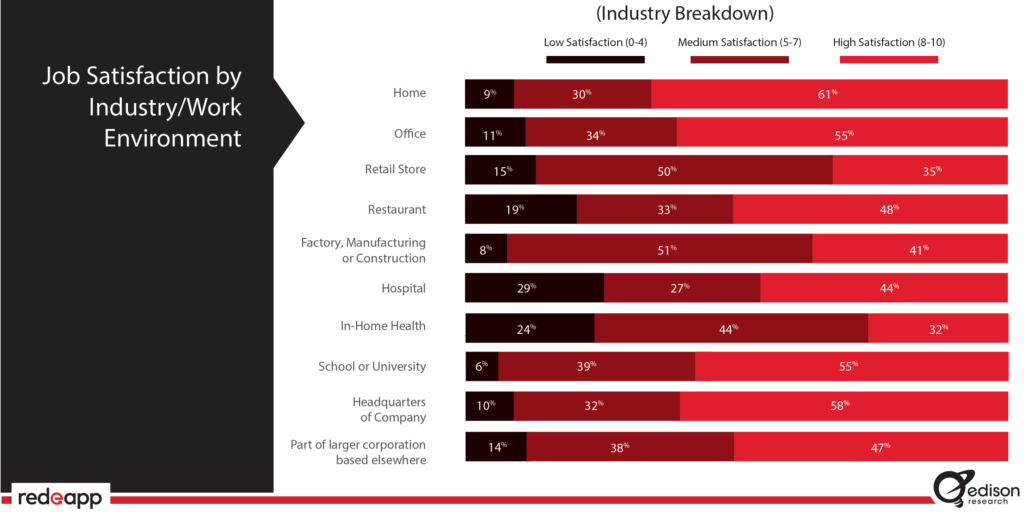Hey there, folks! Today, we’re diving deep into a treasure trove of insights about hourly workers’ jobs and how satisfied they are across various industries. As we continue to delve deeper into the world of hourly worker research, we are putting th![]() e spotlight on what truly makes a happy employee and which industries shine the brightest when it comes to satisfaction.
e spotlight on what truly makes a happy employee and which industries shine the brightest when it comes to satisfaction.
Now, before we jump in, remember our previous chat about hourly worker satisfaction? It’s true, a majority of these hardworking folks seem to be pretty content with their hourly wage gigs. And guess what? Contrary to what you may have been told, size matters! The bigger the company, the higher the satisfaction – it’s like satisfaction scales up with the company’s dimensions.
But cmon, let’s get real here; you’re not just after generalities. You want the juicy details that resonate with your industry, right? As I dug into this data goldmine, a clear pattern emerged. Much like our broader findings, most hourly workers are hovering around a medium to high satisfaction level. However, there are a few industry outliers that might catch your eye.
The Satisfaction Spectrum: Hourly Workers and Industry Dynamics
Now here’s where the real fun begins. Picture this – a scale ranging from “Not satisfied at all” to “Extremely Satisfied.” Now, let’s apply that scale to hourly workers’ job satisfaction across different industries. Hang on tight, as there are a few industry insights you won’t want to miss.

Notice anything interesting up there on the chart? Hospitals and in-home health care are showing some concerning “low satisfaction” rates compared to the rest of the pack. On the flip side, retail and construction site heroes seem to be cruising in the “medium satisfaction” lane – not exactly unsatisfied, but perhaps not bursting with enthusiasm either.
Now, let’s talk about restaurants – they’re serving up a high dose of “low satisfaction” responses. While they do have a chunk of “high satisfaction” champs, keep in mind that 1 in 5 employees are far from thrilled. That’s a bummer for them and their fellow employees’ morale, not to mention profits.
But here’s a twist – hourly workers in an office setting are riding the satisfaction wave. Whether they’re stationed in the office, HQ, or part of a larger corporation, they’re pretty darn content. You see, when you’re with your peers or at the company’s heart, that sense of connection and engagement thrives.
The Satisfaction Connection – Getting Up Close and Personal
Now, let’s zoom in on the satisfaction spotlight. It turns out that working near your comrades or within your company’s headquarters is like hitting the jackpot of job satisfaction. Take a gander at hospital workers versus those providing healthcare at a patient’s home. Even though the tasks are quite similar, the hospital crew is beaming with “high satisfaction” vibes.
And don’t think I forgot about company headquarters versus the larger corporate expanse. Here’s the scoop – when you’re at HQ, your “high satisfaction” meter tends to shoot up. It’s like HQ serves up a special brew of job contentment that’s hard to replicate elsewhere.
Lessons in Connection and Engagement: Connection Is Key
So after all that number crunching, what have we learned? It’s all about the art of connection, my friends. Hourly workers who work closely with their peers or are stationed at a company’s nerve center are rocking the satisfaction charts. It’s like they’re building strong bridges of engagement that keep their spirits high.
But here’s the challenge – companies need to tackle the puzzle of engaging remote workers head-on. Those who work in scattered locations can sometimes miss out on that sense of camaraderie, and that’s where the real tool-time magic needs to happen.
Now, what do you make of these insights? See any patterns that I might’ve missed? Let’s keep the conversation alive in the comments of our socials. Oh, and by the way, if you’re itching for more hourly worker revelations, remember our first report, “Demographics, Devices, and Disconnection.” This independent survey by Edison Research, conducted on behalf of Red e App, dives deep into the hourly workforce landscape.


